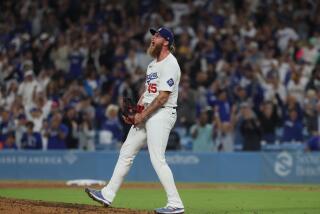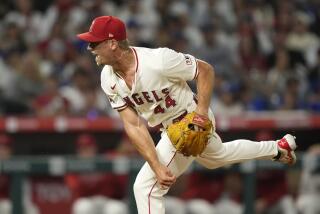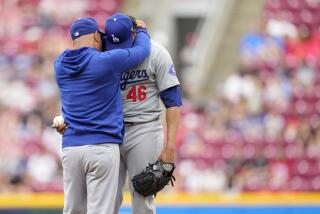Change for the Better?
- Share via
BALTIMORE — Eric Gagne’s fastball hit 98 mph during the peak of his Cy Young Award-winning 2003 season, but it was his 84-mph changeup, which had the look of a fastball but was equipped with rip cord and parachute, that made the Dodger closer so devastating.
Trevor Hoffman had a fastball and slider when he began closing in 1994, but it was his ensuing mastery of a changeup, which floats about 20 mph slower than his fastball, that sent the San Diego Padre soaring toward the top of baseball’s all-time saves list.
Now, imagine if Angel closer Francisco Rodriguez had an effective changeup to go with his 94-mph fastball and snap-hook of a slider that is already considered among the game’s best breaking pitches.
“I guess my quote would be, ‘I’m glad he’s on our team,’ ” Angel first baseman Darin Erstad said. “I know pitchers keep adjusting; they find new stuff. But if Frankie could develop a good changeup ... oh my goodness.”
Boston catcher Jason Varitek, whose Red Sox just split a four-game series against the Angels, didn’t want to fathom the thought of Rodriguez adding a changeup.
“I’m not going to give you an honest answer,” Varitek said, when asked if Rodriguez can thrive with his two pitches, “because I don’t want him to be any better than he already is.”
Bad news for Varitek: Rodriguez, the 23-year-old right-hander who has a 2.79 earned-run average and 28 saves, is toying with the idea of adding a changeup, a pitch he could experiment with over the winter and refine next spring.
But before he sinks so much effort into a third pitch, Rodriguez must answer a question that seems to grow more perplexing with every person asked: Does he really need one?
“No,” said Joe Maddon, Angel bench coach. “For me, it’s all about fastball command. His breaking ball is great, but when he has fastball command, he’s fine.”
The problem is, Rodriguez doesn’t always have command of his fastball. And if he’s not getting ahead with his slider, batters can sit on his fastball, as they did in an eight-appearance stretch from July 28 to Aug. 16 in which Rodriguez had a 9.00 ERA, two losses, three blown saves and 10 walks in seven innings.
With only two pitches, a batter has a 50% chance of correctly guessing what Rodriguez will throw. If Rodriguez has control problems and falls behind in counts, he must rely almost exclusively on a fastball that is good but not overpowering and is easier to hit if Rodriguez can’t throw it on the corners.
A good changeup would provide a third option and make Rodriguez’s fastball seem more crisp in comparison.
“It’s not something I’m thinking about now, but I’d consider it for the future,” Rodriguez said of the changeup. “Down the road, I might need it. No doubt, the more pitches you have, the better it is for you because it will be in the hitters’ minds. They know I throw a fastball and a slider, and they can sit on one pitch to hit.”
Angel pitching coach Bud Black said it’s important to experiment with new pitches and grips, but he’s not sure Rodriguez needs a changeup.
“Do I think it’s imperative? No. Will it add to his arsenal? Yes. Does he need it right now? No,” Black said. “When you look at stuff, you look at batting average against, and he’s one of the best in the league [at .178], so why would he need a new pitch?”
Angel starter John Lackey relied on a fastball and curve for three mostly mediocre seasons, but with a changeup this season, he has become a potential staff ace.
“The changeup has been huge for me,” Lackey said. “The variation in speed has really helped, because I’ve been able to get some strikeouts on fastballs instead of going to the hook with two strikes.”
But that doesn’t necessarily mean Rodriguez would be better with a changeup. “As a reliever, his breaking ball is so good, if guys look for it, he can freeze them with the fastball,” Lackey said. “As a starter, you need a third pitch to set guys up for the next few at-bats.”
Indeed, Troy Percival had a long and fruitful career as Angel closer despite struggling for years to master a second -- let alone third -- pitch to complement his overpowering fastball.
And New York Yankee right-hander Mariano Rivera has been the game’s best closer for a decade with one pitch, a devastating cut-fastball that breaks onto the hands of left-handers.
“But that’s deceiving,” Varitek said of Rivera’s one-pitch wonder reputation. “He changes the tilt. He cuts it, sinks it and four-seams it, so it’s three pitches. There’s not a tremendous variation of speed, but there’s tremendous movement.”
Rodriguez can give his slider two looks, starting it high and away and dropping it into the strike zone, or starting it in the strike zone and bouncing. The latter is a dirt devil of a pitch that can be so effective, Rodriguez once struck out Carlos Delgado on a slider that bounced between Delgado’s legs.
But to set up his out pitch Rodriguez must throw his fastball for strikes, and that ability has been taxed by mechanical problems that have contributed to his recent struggles. A breakthrough may have come Saturday, when Rodriguez pitched a scoreless ninth to save a 4-2 win over Boston.
“My last two outings [before Saturday] I was just throwing the ball as hard as I can and not thinking about locating the ball,” Rodriguez said. “[Saturday] I focused on hitting spots. ... The ball was coming out of my hand good. It had good life. I feel like I’ve turned the corner, that my bad moments have passed.”
Rodriguez, at times, seems to rely too heavily on his slider, and when he runs into trouble, it’s usually because he can’t throw the slider for strikes. Though it may seem Rodriguez loses confidence in his fastball, Black said “60%” of the closer’s pitches are fastballs.
“I don’t think Frankie is a guy we have to worry about losing any confidence,” Angel starter Jarrod Washburn said. “If hitters are guessing between two pitches, I guess it improves their odds, but they still have to hit them, and that’s not easy. I think he’s just going through a learning process.”
Part of that process for a first-year closer is dealing with failure.
“People go through periods when they’re not going to be dominant -- Rivera even went through it at the beginning of this year,” said Toronto’s Shea Hillenbrand, whose Blue Jays scored two runs against Rodriguez in the ninth inning for a 4-3 win last Tuesday.
“But Frankie is nasty. He has one of the best breaking balls in the game. He’ll work through this and will be dominant again. I don’t think the Angels have anything to worry about.”
*
(BEGIN TEXT OF INFOBOX)
Closing strong
Frankie Rodriguez has the third-most strikeouts by an AL reliever with at least 27 saves (through Monday):
*--* Pitcher, Team SO SV B.J. Ryan, Baltimore 81 27 Joe Nathan, Minnesota 67 31 FRANKIE RODRIGUEZ, ANGELS 65 28 Mariano Rivera, New York 64 33 Francisco Cordero, Texas 61 27 Danys Baez, Tampa Bay 44 29 Eddie Guardado, Seattle 36 29 Bob Wickman, Cleveland 26 32 Dustin Hermanson, Chicago 26 30
*--*
More to Read
Go beyond the scoreboard
Get the latest on L.A.'s teams in the daily Sports Report newsletter.
You may occasionally receive promotional content from the Los Angeles Times.







